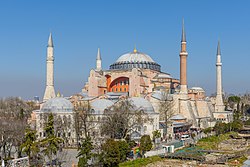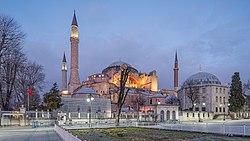Aya Sophia
Aya Sophia (Bahasa Yunani: Ἁγία Σοφία); Hagia Sophia (bahasa Turki: Ayasofya; bahasa Arab; آيا صوفيا, berasal daripada perkataan Yunani: Ἁγία Σοφία, "Hikmah Suci"; bahasa Latin: Sancta Sophia atau Sancta Sapientia) merupakan sebuah struktur bangunan muzium yang terletak di Istanbul, Turki. Bangunan ini sering dianggap sebagai sebuah bangunan teragung dan tercantik di dunia. Pada mulanya, Aya Sophia dibina sebagai sebuah katedral bagi penganut Kristian Ortodoks tetapi kemudian diubahsuai menjadi sebuah masjid oleh kerajaan Uthmaniyyah pada tahun 1453. Pemerintah republik Turki telah menjadikannya sebagai muzium bermula pada 1935 dan bertukar menjadi masjid semula pada 2020 atas ketetapan Presiden Turki.[1][2]
 Pandangan dari luar Aya Sophia | |
| Maklumat umum | |
|---|---|
Pereka bentuk | Isidore dari Miletus Anthemius dari Tralles |
| Jenis | Katedral Ortodoks Timur (537–1204, 1261–1453) Katedral Katholik Rom (1204–1261) |
| Bahan | Ashlar, bata |
| Panjang | 82 m (269 ka) |
| Lebar | 73 m (240 ka) |
| Tinggi | 55 m (180 ka) |
Mula dibina pada | 532 |
Disiapkan pada | 537 |
| Maklumat lokasi | |
 | |
| Koordinat | 41°00′31″N 28°58′48″E / 41.008548°N 28.979938°EKoordinat: 41°00′31″N 28°58′48″E / 41.008548°N 28.979938°E |
| Lokasi | Constantinople (kini Istanbul, Turki) |
| sunting | |



Sejarah sunting
Aya Sophia asalnya dibina sebagai sebuah katedral di antara 532 dan 537 SM atas arahan Maharaja Byzantine Justinian. Ia direka oleh dua orang arkitek, Isidore dari Miletus dan Anthemius dari Tralles. Aya Sophia menjadi gereja besar di Constantinople selama hampir 1,000 tahun.
Pada 1453, selepas kejatuhan Constantinople kepada empayar Uthmaniyah, Sultan Muhammad al-Fatih telah menukar Gereja Ortodoks Bizantium ini menjadi masjid. Loceng, altar dan barang-barang berunsurkan agama Kristian kemudian dibuang sementara lukisan pada dinding pula ditampal. Ia telah digantikan dengan unsur-unsur Islam seperti mihrab, mimbar dan empat menara di luar bangunan. Aya Sophia kekal berfungsi sebagai sebuah masjid sehingga tahun 1935 apabila ia ditukar kepada muzium oleh kerajaan Republik Turki.
Selama hampir 500 tahun, Hagia Sophia menjadi masjid utama di Istanbul dan menjadi model pada masjid-masjid lain seperti Masjid Sultan Ahmed (Masjid Biru di Istanbul), Masjid Sehzade, Masjid Suleymaniye dan Masjid Rustem Pasha.
Gambaran sunting
Hagia Sophia mempunyai satu kubah besar di tengah (diameter 31.87 m dan tinggi 55.60 m dari lantai) yang terletak di atas singgah kubah yang disokong oleh empat tiang sambut.
Dinding dalam ditutupi dengan batu marmar, mozek emas dan lain-lain. Di bahagian luar, dinding stuko ringkas menyerlahkan lagi kekubah dan kubah utama.
Rujukan sunting
- ^ Gall, Carlotta (10 Julai 2020). "Erdogan Signs Decree Allowing Hagia Sophia to Be Used as a Mosque Again". The New York Times (dalam bahasa Inggeris).
- ^ Dal, Aylin; Karadag, Kemal (10 Julai 2020). "Turkey: Court strikes down Hagia Sophia museum decree" (dalam bahasa Inggeris). Agensi Anadolu.
Bibliografi sunting
- Boyran, Ebru; Fleet, Kate (2010). A social History of Ottoman Istanbul. Cambridge: Cambridge University Press. ISBN 978-0-521-19955-1.
- Brubaker, Leslie; Haldon, John (2011). Byzantium in the Iconoclast era (ca 680–850). Cambridge: Cambridge University Press. ISBN 978-0-521-43093-7.
- Hagia Sophia Church [pautan mati], also known as Church of Holy Wisdom.
- Hagia Sophia. [1]. Accessed 23 Sept 2014.
- Hoffman, Volker (1999). Die Hagia Sophia in Istanbul (dalam bahasa German). Bern: Lang. ISBN 3-906762-81-5.CS1 maint: unrecognized language (link)
- Janin, Raymond (1953). La Géographie Ecclésiastique de l'Empire Byzantin. 1. Part: Le Siège de Constantinople et le Patriarcat Oecuménique. 3rd Vol. : Les Églises et les Monastères. Paris: Institut Français d'Etudes Byzantines.
- Mainstone, Rowland J. (1997). Hagia Sophia: Architecture, Structure, and Liturgy of Justinian's Great Church (reprint edition). W W Norton & Co Inc. ISBN 0-500-27945-4..
- Mamboury, Ernest (1953). The Tourists' Istanbul. Istanbul: Çituri Biraderler Basımevi.
- Müller-Wiener, Wolfgang (1977). Bildlexikon zur Topographie Istanbuls: Byzantion, Konstantinupolis, Istanbul bis zum Beginn d. 17 Jh (dalam bahasa German). Tübingen: Wasmuth. ISBN 978-3-8030-1022-3.CS1 maint: unrecognized language (link)
- Necipoĝlu, Gulru (2005). The Age of Sinan: Architectural Culture in the Ottoman Empire. London: Reaktion Books. ISBN 978-1-86189-244-7.
- Ronchey, Silvia; Braccini, Tommaso (2010). Il romanzo di Costantinopoli. Guida letteraria alla Roma d'Oriente (dalam bahasa Italian). Torino: Einaudi. ISBN 978-88-06-18921-1.CS1 maint: unrecognized language (link)
- Runciman, Steven (1965). The Fall of Constantinople, 1453. Cambridge: Cambridge University Press. p. 145. ISBN 0-521-39832-0.
- Turner, J. (1996). Grove Dictionary of Art. Oxford: Oxford University Press. ISBN 0-19-517068-7.
Bacaan lanjut sunting
- Alchermes, Joseph D. (2005). "Art and Architecture in the Age of Justinian". Dalam Maas, Michael (penyunting). The Cambridge Companion to the Age of Justinian. Cambridge: Cambridge U.P. m/s. 343–375. ISBN 978-0-521-52071-3.
- Balfour, John Patrick Douglas (1972). Hagia Sophia. W.W. Norton & Company. ISBN 978-0-88225-014-4.
- Cimok, Fatih (2004). Hagia Sophia. Milet Publishing Ltd. ISBN 978-975-7199-61-8.
- Doumato, Lamia (1980). The Byzantine church of Hagia Sophia: Selected references. Vance Bibliographies. ASIN B0006E2O2M.
- Goriansky, Lev Vladimir (1933). Haghia Sophia: analysis of the architecture, art and spirit behind the shrine in Constantinople dedicated to Hagia Sophia. American School of Philosophy. ASIN B0008C47EA.
- Harris, Jonathan, Constantinople: Capital of Byzantium. Hambledon/Continuum (2007). ISBN 978-1-84725-179-4
- Howland Swift, Emerson (1937). The bronze doors of the gate of the horologium at Hagia Sophia. University of Chicago. ASIN B000889GIG.
- Kahler, Heinz (1967). Haghia Sophia. Praeger. ASIN B0008C47EA.
- Kinross, Lord (1972). Hagia Sophia, Wonders of Man. Newsweek. ASIN B000K5QN9W.
- Kleinbauer, W. Eugene; Anthony White (2007). Hagia Sophia. London: Scala Publishers. ISBN 978-1-85759-308-2.
- Kleinbauer, W. Eugene (2000). Saint Sophia at Constantinople: Singulariter in Mundo (Monograph (Frederic Lindley Morgan Chair of Architectural Design), No. 5.). William L. Bauhan. ISBN 978-0-87233-123-5.
- Krautheimer, Richard (1984). Early Christian and Byzantine Architecture. New Haven, CT: Yale University Press. ISBN 978-0-300-05294-7.
- Mainstone, R. J. (1997). Hagia Sophia: Architecture, Structure, and Liturgy of Justinian's Great Church. London: Thames & Hudson. ISBN 978-0-500-27945-8.
- Mainstone, Rowland J. (1988). Hagia Sophia. Architecture, structure and liturgy of Justinian's great church. London: Thames & Hudson. ISBN 0-500-34098-6.
- Mango, Cyril; Ahmed Ertuğ (1997). Hagia Sophia. A vision for empires. Istanbul.
- Mark, R.; Çakmaktitle, AS. (1992). Hagia Sophia from the Age of Justinian to the Present. Princeton Architectural. ISBN 978-1-878271-11-2.
- Nelson, Robert S. (2004). Hagia Sophia, 1850–1950: Holy Wisdom Modern Monument. Chicago: University Of Chicago Press. ISBN 978-0-226-57171-3.
- Özkul, T. A. (2007). Structural characteristics of Hagia Sophia: I-A finite element formulation for static analysis. Elsevier.
- Scharf, Joachim:Der Kaiser in Proskynese. Bemerkungen zur Deutung des Kaisermosaiks im Narthex der Hagia Sophia von Konstantinopel. In: Festschrift Percy Ernst Schramm zu seinem siebzigsten Geburtstag von Schülern und Freunden zugeeignet, Wiesbaden 1964, S. 27–35.
- Swainson, Harold (2005). The Church of Sancta Sophia Constantinople: A Study of Byzantine Building. Boston, MA: Adamant Media Corporation. ISBN 978-1-4021-8345-4.
- Yucel, Erdem (2005). Hagia Sophia. Scala Publishers. ISBN 978-1-85759-250-4.
- Weitzmann, Kurt, ed., Age of spirituality: late antique and early Christian art, third to seventh century, no. 592, 1979, Metropolitan Museum of Art, New York, ISBN 978-0-87099-179-0
Artikel sunting
- Bordewich, Fergus M., "A Monumental Struggle to Preserve Hagia Sophia" Diarkibkan 2013-04-08 di Archive-It, Smithsonian magazine, December 2008
Mosaics sunting
- Hagia Sophia, hagiasophia.com: Mosaics.
- MacDonald, William Lloyd (1951). The uncovering of Byzantine mosaics in Hagia Sophia. Archaeological Institute of America. ASIN B0007GZTKS.
- Mango, Cyril (1972). The mosaics of St. Sophia at Istanbul: The church fathers in the north Tympanum. Dumbarton Oaks Center for Byzantine Studies. ASIN B0007CAVA0.
- Mango, Cyril (1968). The Apse mosaics of St. Sophia at Istanbul: Report on work carried out in 1964. Johnson Reprints. ASIN B0007G5RBY.
- Mango, Cyril; Heinz Kahler (1967). Hagia Sophia: With a Chapter on the Mosaics. Praeger. ASIN B0000CO5IL.
- Teteriatnikov, Natalia B. (1998). Mosaics of Hagia Sophia, Istanbul: The Fossati Restoration and the Work of the Byzantine Institute. Dumbarton Oaks Research Library and Collection. ISBN 978-0-88402-264-0.
- Riccardi, Lorenzo (2012). Alcune riflessioni sul mosaico del vestibolo sud-ovest della Santa Sofia di Costantinopoli, in Vie per Bisanzio. VIII Congresso Nazionale dell’Associazione Italiana di Studi Bizantini (Venezia 25-28 novembre 2009), a cura di Antonio Rigo, Andrea Babuin e Michele Trizio. Bari. m/s. 357–371. ISBN 978-88-7470-229-9. Dicapai pada 30 September 2014.
- Yücel, Erdem (1988). The mosaics of Hagia Sophia. Efe Turizm. ASIN B0007CBGYA.
Pautan luar sunting
| Wikimedia Commons ada media yang berkaitan: |
| Wikisource mempunyai teks sebuah rencana New International Encyclopedia tahun 1905 tentang Hagia Sophia. |
- Contemporary description Diarkibkan 2015-09-04 di Wayback Machine by Procopius, Buildings (De Aedificiis), published in 561.

